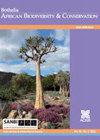Long-term changes in forest cover in a global biodiversity hotspot in southern Mozambique
IF 0.5
4区 生物学
Q4 PLANT SCIENCES
引用次数: 3
Abstract
Background: Deforestation is a complex and dynamic process of widespread concern in sub-Saharan Africa which is influenced by a range of social, economic and biophysical factors. Objectives: The aim of this study was to analyse patterns of deforestation and its potential drivers in the Licuáti Forest Reserve, a biodiversity hotspot in southern Mozambique between 1990 and 2016. Method: We performed image classification on Landsat imagery at six time steps and interviewed local community members to understand the spatial pattern and rate of forest cover loss over time. We also examined changes in the incidence of fire. Results: A substantial increase in the rate of deforestation since 1990 was detected in this vulnerable thicket vegetation. The probability of deforestation was significantly higher near the major roads, where houses are located. This suggests that the proximity of human settlements to the forest, and access to charcoal markets in urban areas, influenced the spatial pattern. Two key factors 1) charcoal production, and 2) the establishment of settlements and agricultural lands were identified as proximate causes of deforestation. In addition, fires associated with these two causes might amplify the loss of forests in the area. Conclusions: Complex interactions between the drivers of deforestation and socio-economic factors were suggested, as most of the charcoal produced in the region is transported to Maputo. Ongoing road improvements and infrastructural development in the region will likely accelerate the decline in forest cover in the future. This has implications for the biodiversity of the region as well as for the sustainability of local livelihoods, as they often depend on forest products for their daily uses.莫桑比克南部全球生物多样性热点地区森林覆盖的长期变化
背景:森林砍伐是撒哈拉以南非洲广泛关注的一个复杂和动态的过程,受到一系列社会、经济和生物物理因素的影响。目的:本研究的目的是分析1990年至2016年间莫桑比克南部生物多样性热点Licuáti森林保护区的森林砍伐模式及其潜在驱动因素。方法:对Landsat影像进行6个时间步骤的图像分类,并对当地社区成员进行访谈,了解森林覆盖的空间格局和损失率。我们还研究了火灾发生率的变化。结果:自1990年以来,这一脆弱的灌丛植被的森林砍伐率大幅增加。在房屋所在的主要道路附近,森林砍伐的可能性要高得多。这表明人类住区与森林的接近程度以及城市地区进入木炭市场的机会影响了空间格局。两个关键因素(1)木炭生产和2)定居点和农业用地的建立被确定为森林砍伐的近因。此外,与这两个原因相关的火灾可能会加剧该地区森林的损失。结论:森林砍伐的驱动因素与社会经济因素之间存在复杂的相互作用,因为该地区生产的大部分木炭都被运往马普托。该地区正在进行的道路改善和基础设施发展可能会在未来加速森林覆盖的减少。这对该地区的生物多样性以及当地生计的可持续性都有影响,因为他们的日常生活往往依赖森林产品。
本文章由计算机程序翻译,如有差异,请以英文原文为准。
求助全文
约1分钟内获得全文
求助全文
来源期刊

Bothalia
生物-植物科学
CiteScore
1.70
自引率
0.00%
发文量
12
期刊介绍:
Bothalia: African Biodiversity & Conservation is published by AOSIS for the South African National Biodiversity Institute (SANBI) and aims to disseminate knowledge, information and innovative approaches that promote and enhance the wise use and management of biodiversity in order to sustain the systems and species that support and benefit the people of Africa.
The journal was previously published as Bothalia, and had served the South African botanical community since 1921. However the expanded mandate of SANBI necessitated a broader scope for the journal, and in 2014, the subtitle, African Biodiversity & Conservation was added to reflect this change.
 求助内容:
求助内容: 应助结果提醒方式:
应助结果提醒方式:


